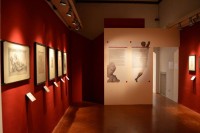By Mackenzie Constantinou (Lorenzo de’ Medici)
The exhibition Mortal Veil. Michelangelo and Depictions of the Human Body explores different components of Michelangelo’s studies of the human form. The students in the Master’s in Museum Studies program at the Lorenzo de’ Medici Institute and Marist College had the opportunity to organize and curate this temporary exhibition at Museo della Casa Buonarroti. ‘Mortal Veil’ was selected for the title of this exhibition, because the major interest of Michelangelo was the life of the soul, as expressed in the beautiful structure and movement of the human body, which he referred to as the mortal veil of divine intentions. Due to the artist’s great interest in depicting the complex human form, this theme was conveyed throughout the entire exhibition. The exhibition focuses on three motifs evident in Michelangelo’s figure studies: anatomy, movement, and classical antiquity.
Although Michelangelo considered the flesh simply a shell for the divine, he still frequently studied human anatomy. While complete anatomical depiction in a medical sense was not Michelangelo’s intent when studying the human form, he continuously devoted himself to the biological study of the body. Michelangelo’s depictions demonstrate his understanding of how muscles move together. His studies reveal that the body is more than bones, muscles, veins, and nerves and that its representation is capable of creating a wide range of emotions and actions. Michelangelo constantly drew figures repeatedly in different poses, or depicted bodies in contorted or realistically uncomfortable positions. These studies helped the artist understand the complicated series of movements that the body can perform. These sketches and one sonnet are displayed within one room and set against Pompeii red walls. As the visitor enters the museum they can instantly see a 3-d photographic collage of different figures from this exhibition, and this didactic appears to be jumping through the doorway.
The exhibition provides an entire room dedicated to educational didactic elements, which was also designed by students in the Lorenzo de’ Medici Institute Museum Studies Master’s program. This room seems detached and does not seem to stylistically correlate with the other part of the exhibition. Though the different educational tools are extremely helpful and engaging for different groups and age ranges, the presentation does not entice visitors. Furthermore, the wall texts, brochures, and informational panels, which are in Italian and English, provide the necessary background for visitors to understand the theme of the exhibition. Also, there is a visitor questionnaire available for the public to convey their thoughts concerting this show.
The temporary exhibition provides a unique opportunity for the Master’s course to work with the Museo della Casa Buonarroti and apply the numerous different concepts they have learned throughout their course work. The show conveys a unique theme and presents interesting sketches, such as Cleopatra which has not been displayed to the public in over a decade. For more information in regards to this exhibition please visit the website: http://www.casabuonarroti.it/it/2015/04/09/velo-mortale-michelangelo-e-la-rappresentazione-del-corpo-umano/
Velo mortale. Michelangelo e la rappresentazione del corpo umano
La mostra Velo mortale. Michelangelo e la rappresentazione del corpo umano esplora diverse componenti degli studi di Michelangelo sulla forma umana.
Gli studenti del Master in Museum Studies presso l’Istituto Lorenzo de ‘Medici e Marist College hanno avuto la possibilità di organizzare e curare questa mostra temporanea al Museo di Casa Buonarroti.
Il velo mortale è stato scelto come titolo della mostra, perché il maggior interesse di Michelangelo è stata la vita dell’anima, espressa nella bella struttura e nel movimento del corpo umano, al quale si riferisce come il “velo mortale” delle intenzioni divine . A causa del grande interesse dell’artista nel rappresentare la complessità della forma umana, si è potuto trasmettere questo tema in tutta la mostra.
L’esposizione si concentra su tre elementi evidenti negli studi di figura di Michelangelo: l’anatomia, il movimento e l’antichità classica. Nonostante Michelangelo considerasse la carne semplicemente come un guscio per il divino, studiò a lungo l’anatomia umana. Se da un lato la completa raffigurazione anatomica, in senso medico, non era l’intento principale di Michelangelo mentre analizzava la forma umana, dall’altro, egli si dedicava continuamente allo studio biologico del corpo. Le raffigurazioni di Michelangelo dimostrano la sua comprensione di come i muscoli si muovono insieme. I suoi studi rivelano che il corpo è più di ossa, muscoli, vene e nervi, e che la sua rappresentazione è in grado di creare una vasta gamma di emozioni e azioni. Michelangelo ritrae costantemente e ripetutamente figure in diverse pose, o dipinge figure raffigurate in posizioni contorte o in realistiche posizioni di disagio. Questi studi hanno aiutato l’artista a capire la complicata serie di movimenti che il corpo può eseguire.
I disegni ed un sonetto sono esposti all’interno di una stanza disposti contro le pareti rosso Pompei. Quando il visitatore entra nel museo può vedere immediatamente un collage fotografico 3D di diverse figure presenti in mostra, questa didattica sembra essere il salto oltre la soglia.
La mostra offre inoltre un’ intera sala dedicata agli elementi didattici ed educativi, anche questo spazio è stato progettato dagli studenti che seguono il master in Museum Studies della Lorenzo de ‘Medici. La sala sembra distaccata e appare non legata stilisticamente all’altra parte della mostra. Anche se i diversi strumenti educativi sono estremamente utili e coinvolgenti per diversi gruppi e fasce di età, la presentazione non invoglia i visitatori.
Inoltre, i testi alla parete, brochure e pannelli informativi, che sono in italiano e inglese, forniscono il background necessario ai visitatori per capire il tema della mostra. Vi è anche un questionario a disposizione del pubblico per trasmettere i loro pensieri sulla mostra.
L’esposizione rappresenta un’occasione unica per il Master di lavorare con il Museo della Casa Buonarroti e applicare i numerosi diversi concetti appresi durante il lavoro del corso. La mostra trasmette un tema unico e presenta disegni interessanti, come Cleopatra, che non è stata mostrata al pubblico in oltre un decennio.
Per ulteriori informazioni in riferimento a questa mostra si prega di visitare il sito:http://www.casabuonarroti.it/it/2015/04/09/velo-mortale-michelangelo-e-la-rappresentazione-del-corpo-umano/
